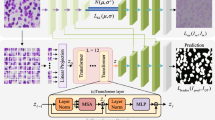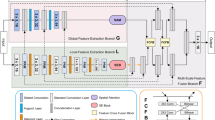Abstract
There are many problems in the medical images, such as irregular edges and noises, the pathological information is difficult to be obtained. So it brings difficulties to doctors to accurately diagnose the diseases. Therefore, in medical image processing, traditional image segmentation methods are based on region similarity and region difference. Medical image segmentation plays a very important role in the field of clinical medicine research. Meanwhile, deep learning methods used for medical image segmentation can abstract image segmentation as a problem of feature representation and parameter optimization. In order to solve the problem of losing feature information in the process of up-sampling and down-sampling, a new multilevel feature fusion network is proposed for medical image segmentation. Experiments on the open data set show that the proposed method can effectively improve the segmentation accuracy.










Similar content being viewed by others
References
Teng, L., Li, H., Yin, S., & Sun, Y. (2019). Improved krill group-based region growing algorithm for image segmentation. International Journal of Image and Data Fusion., 10(4), 327–341. https://doi.org/10.1080/19479832.2019.1604574
Arora, J., & Tushir, M. (2020). Intuitionistic level set segmentation for medical image segmentation. Recent Advances in Computer Science and Communications, 13, 1039–1046.
Yang, B., Liu, X., & Zhang, J. (2020). Medical image segmentation based on deep feature aggregation network. Computer Engineering. https://doi.org/10.19678/j.issn.1000-3428.0057330
Yin, S., Meng, L., & Liu, J. (2019). A new apple segmentation and recognition method based on modified fuzzy C-means and hough transform. Journal of Applied Science and Engineering., 22(2), 349–354.
Bi, J., & Yin, S. (2018). A new graph semi-supervised learning method for medical image automatic annotation. In 2018 IEEE International Congress on Cybermatics i-Things, Halifax, NS, Canada, Canada. https://doi.org/10.1109/Cybermatics_2018.2018.00041.
Nie, D., Wang, L., Gao, Y., & Shen, D. (2016). Fully convolutional networks for multi-modality isointense infant brain image segmentation. In 2016 IEEE 13th international symposium on biomedical imaging (ISBI) (pp. 1342–1345), Prague. https://doi.org/10.1109/ISBI.2016.7493515.
Zhang, W., Li, R., Deng, H., et al. (2015). Deep convolutional neural networks for multi-modality isointense infant brain image segmentation. NeuroImage, 108, 214–224.
Dolz, J., Desrosiers, C., Wang, L., et al. (2020). Deep CNN ensembles and suggestive annotations for infant brain MRI segmentation. Computerized Medical Imaging and Graphics, 79, 101660.
Li, Q., Feng, B., Xie, L., Liang, P., Zhang, H., & Wang, T. (2016). A cross-modality learning approach for vessel segmentation in retinal images. IEEE Transactions on Medical Imaging, 35(1), 109–118. https://doi.org/10.1109/TMI.2015.2457891
Geng, L., Qiu, L., Wu, J., Xiao, Z. T., & Zhang, F. (2019). Segmentation of retinal image vessels based on fully convolutional network with depth wise separable convolution and channel weighting. Journal of Biomedical Engineering, 36(01), 107–115.
Liang, L. M., Sheng, X. Q., Guo, K., & Deng, G. H. (2019). Improved U-net fundus retinal vessels segmentation. Application Research of Computers, 37(4), 1–6.
Teng, L., Li, H., & Karim, S. (2019). DMCNN: A deep multiscale convolutional neural network model for medical image segmentation. Journal of Healthcare Engineering, 2019, 8597606.
Ronneberger, O., Fischer, P., & Brox, T. (2015). U-Net: Convolutional networks for biomedical image segmentation. In International conference on medical image computing and computer-assisted intervention (pp. 234–241). Springer International Publishing.
Li, X., Chen, H., Qi, X., et al. (2018). H-DenseUNet: Hybrid densely connected UNet for liver and tumor segmentation from CT volumes. IEEE Transactions on Medical Imaging, 37(12), 2663–2674.
Aubert-Broche, B., Evans, A. C., & Collins, L. (2006). A new improved version of the realistic digital brain phantom. NeuroImage, 32(1), 138–145.
Staal, J., Abramoff, M. D., Niemeijer, M., Viergever, M. A., & van Ginneken, B. (2004). Ridge-based vessel segmentation in color images of the retina. IEEE Transactions on Medical Imaging, 23(4), 501–509. https://doi.org/10.1109/TMI.2004.825627
Owen, C. G., Rudnicka, A. R., Mullen, R., et al. (2009). Measuring retinal vessel tortuosity in 10-year-old children: Validation of the Computer-Assisted Image Analysis of the Retina (CAIAR) program. Investigative Ophthalmology & Visual Science, 50(5), 2004–2010.
Teng, L., Li, H., Yin, S., Karim, S., & Sun, Y. (2020). An active contour model based on hybrid energy and fisher criterion for image segmentation. International Journal of Image and Data Fusion., 11(1), 97–112.
Guotai, W., Zuluaga, M. A., Wenqi, L., et al. (2019). DeepIGeoS: A deep interactive geodesic framework for medical image segmentation. IEEE Transactions on Pattern Analysis and Machine Intelligence, 41(7), 1559–1572.
Yin, S., Li, H., Liu, D., & Karim, S. (2020). Active contour modal based on density-oriented BIRCH clustering method for medical image segmentation. Multimedia Tools and Applications, 79, 31049–31068.
Corbat, L., Nauval, M., Henriet, J., et al. (2020). A fusion method based on Deep Learning and Case-Based Reasoning which improves the resulting medical image segmentations. Expert Systems with Applications, 147, 113200.
Author information
Authors and Affiliations
Corresponding author
Additional information
Publisher's Note
Springer Nature remains neutral with regard to jurisdictional claims in published maps and institutional affiliations.
Rights and permissions
About this article
Cite this article
Qiu, X. A New Multilevel Feature Fusion Network for Medical Image Segmentation. Sens Imaging 22, 23 (2021). https://doi.org/10.1007/s11220-021-00346-2
Received:
Revised:
Accepted:
Published:
DOI: https://doi.org/10.1007/s11220-021-00346-2




